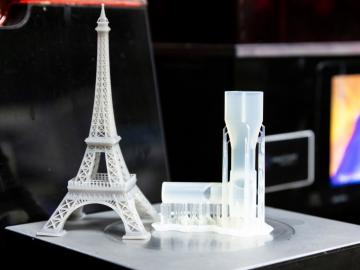
Filter News
Area of Research
- (-) Biology and Environment (56)
- (-) Materials (76)
- Advanced Manufacturing (1)
- Biological Systems (1)
- Building Technologies (1)
- Clean Energy (63)
- Computational Engineering (1)
- Computer Science (2)
- Electricity and Smart Grid (1)
- Energy Sciences (1)
- Fuel Cycle Science and Technology (1)
- Fusion and Fission (19)
- Fusion Energy (3)
- Isotope Development and Production (1)
- Isotopes (15)
- Materials Characterization (2)
- Materials Under Extremes (1)
- National Security (26)
- Neutron Science (32)
- Nuclear Science and Technology (2)
- Supercomputing (73)
News Topics
- 3-D Printing/Advanced Manufacturing (6)
- Advanced Reactors (1)
- Artificial Intelligence (3)
- Big Data (5)
- Bioenergy (18)
- Biology (24)
- Biomedical (3)
- Biotechnology (5)
- Buildings (3)
- Chemical Sciences (17)
- Clean Water (3)
- Climate Change (18)
- Composites (3)
- Computer Science (8)
- Coronavirus (4)
- Critical Materials (4)
- Decarbonization (13)
- Energy Storage (6)
- Environment (35)
- Exascale Computing (2)
- Frontier (2)
- Fusion (2)
- Grid (3)
- High-Performance Computing (10)
- Hydropower (3)
- Irradiation (1)
- Isotopes (3)
- Machine Learning (3)
- Materials (41)
- Materials Science (9)
- Mathematics (2)
- Mercury (2)
- Microscopy (5)
- Molten Salt (1)
- Nanotechnology (4)
- National Security (2)
- Net Zero (2)
- Neutron Science (8)
- Nuclear Energy (4)
- Partnerships (7)
- Physics (10)
- Polymers (4)
- Quantum Computing (2)
- Quantum Science (1)
- Renewable Energy (2)
- Simulation (13)
- Summit (2)
- Sustainable Energy (11)
- Transportation (3)
Media Contacts

Bob Bolton may have moved to a southerly latitude at ORNL, but he is still stewarding scientific exploration in the Arctic, along with a project that helps amplify the voices of Alaskans who reside in a landscape on the front lines of climate change.

ORNL is leading two nuclear physics research projects within the Scientific Discovery through Advanced Computing, or SciDAC, program from the Department of Energy Office of Science.

Researchers from Oak Ridge National Laboratory and Northeastern University modeled how extreme conditions in a changing climate affect the land’s ability to absorb atmospheric carbon — a key process for mitigating human-caused emissions. They found that 88% of Earth’s regions could become carbon emitters by the end of the 21st century.

A team of scientists with ORNL has investigated the behavior of hafnium oxide, or hafnia, because of its potential for use in novel semiconductor applications.

Oak Ridge National Laboratory scientists studied hot springs on different continents and found similarities in how some microbes adapted despite their geographic diversity.

Speakers, scientific workshops, speed networking, a student poster showcase and more energized the Annual User Meeting of the Department of Energy’s Center for Nanophase Materials Sciences, or CNMS, Aug. 7-10, near Market Square in downtown Knoxville, Tennessee.

Yaoping Wang, postdoctoral research associate at ORNL, has received an Early Career Award from the Asian Ecology Section, or AES, of the Ecological Society of America.

Madhavi Martin brings a physicist’s tools and perspective to biological and environmental research at the Department of Energy’s Oak Ridge National Laboratory, supporting advances in bioenergy, soil carbon storage and environmental monitoring, and even helping solve a murder mystery.

Autonomous labs are changing the nature of scientific investigation. Instead of humans manually orchestrating every part of an experiment, programmed equipment can carry out necessary functions. This workflow accelerates the pace of discovery by reducing the number of monotonous tasks that researchers must perform.

Takaaki Koyanagi, an R&D staff member in the Materials Science and Technology Division of ORNL, has received the TMS Frontiers of Materials award.


